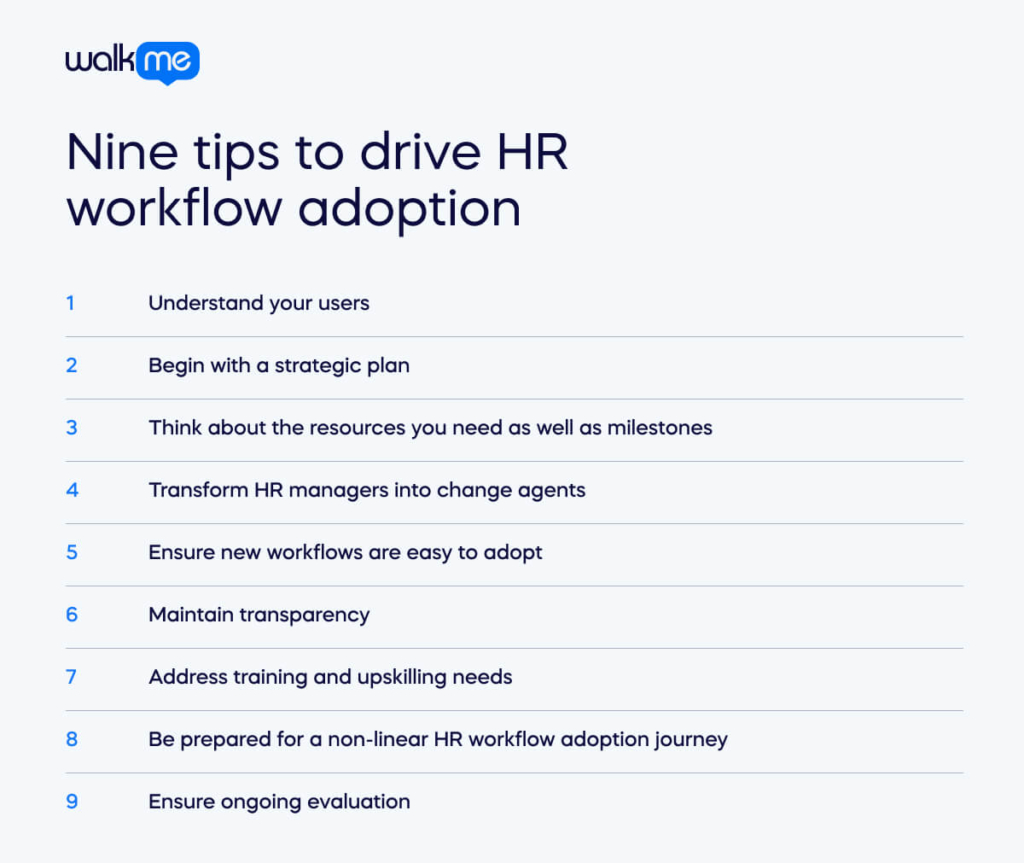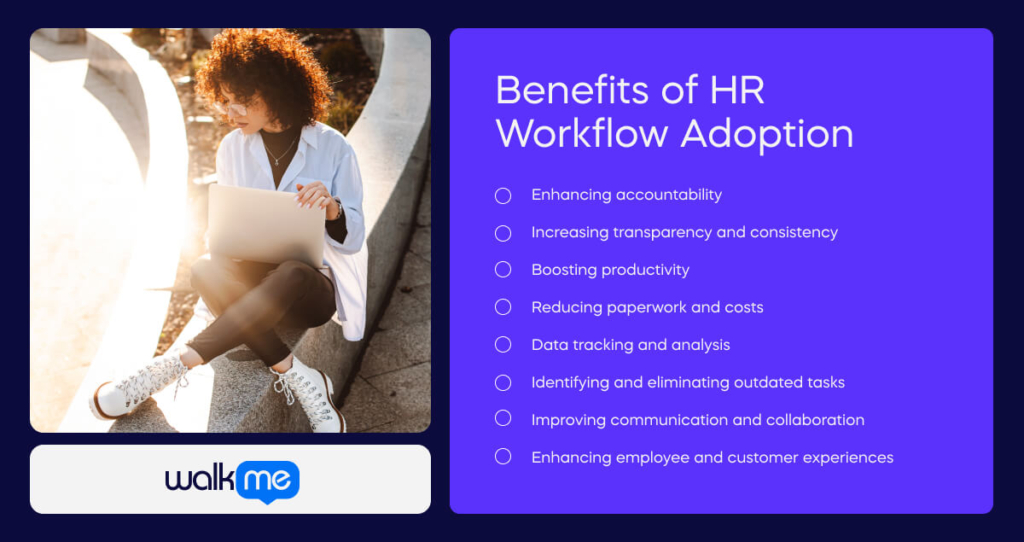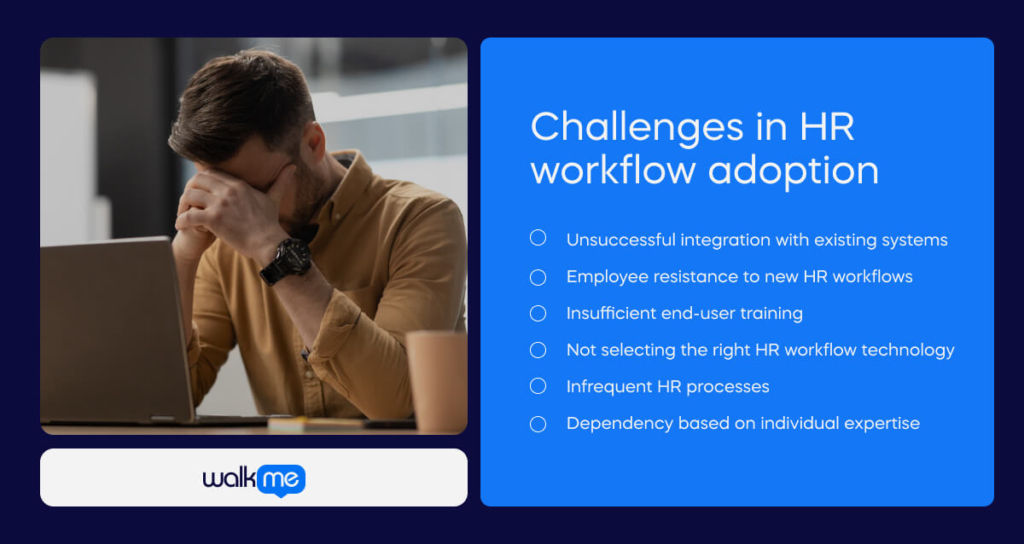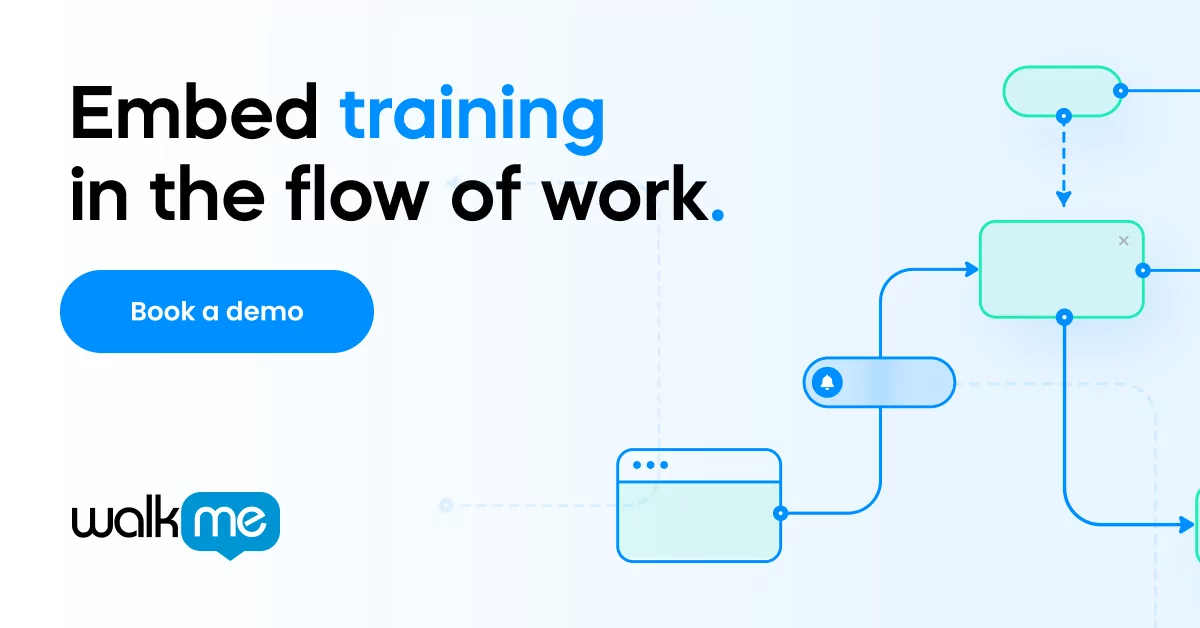Research from Gartner states that 57% of leaders see the continued adoption of HR technology as a major challenge. Without adoption, technology fails to add value and becomes a burden, incurring ongoing costs.
It can also increase the likelihood of switching vendors, which is costly in terms of time and money.
But, when done properly, implementing HR technology offers various benefits. It can improve employee productivity, skills, and onboarding and offboarding experience.
This article explains HR workflow adoption and discusses the nine best tips for driving its success at your company.
Next, we will look at why HR workflow adoption is important. Following this, we will consider its benefits and challenges. Then, we will provide you with the best practices you can apply to successfully adopt HR workflows.
What is HR workflow adoption?
HR workflow adoption signifies when the HR team becomes proficient in using technological solutions to enhance their current and developing workflows. This action will then improve productivity and reduce costs.
HR workflows are the recurring activities defining every element of an HR procedure.
You can design them to manage the myriad of manual tasks inherent in each process. They will incorporate specific approval guidelines, task completions, and notification procedures.
However, managing HR workflows manually can be labor-intensive and ineffective. HR technology can automate manual tasks like data entry and cut the chance of human errors. These workflows also ensure you can store all data and documents in the cloud.
Tasks that can enjoy HR workflows include employee onboarding, performance management, benefits administration, and leave requests.
For instance, HR workflows can enhance the employee onboarding process.
This type of automation allows HR to dedicate more time to welcoming new employees.
For instance, on an employee’s first day, HR workflow software can begin onboarding by automatically scheduling an interview between the recruit and the HR department.
Following this, it could arrange another interview between the recruit and their assigned manager.
Once done, it could send out notifications with details of the employee onboarding interviews.
The onboarding workflow could also assign an e-learning training path for the new employee.
Or, if an employee wishes to request time off, they can apply a relevant workflow. This will allow them to choose the type of leave they need and attach any relevant documents.
The request is sent to the manager via email or direct notification. This removes the need for the manager to check the relevant HR workflow system.
Upon the manager’s approval, the automated system sends the request to the HR department for final review.
Once you’ve authorized the leave, the workflow will reflect this.
Nine tips to drive HR workflow adoption

Here are some key ways that you can accelerate and sustain your HR workflow adoption efforts:
Understand your users
Understanding your employees’ needs is a pivotal step in adopting new workflows. This exercise facilitates developing and providing products customized to meet their specific requirements.
Construct comprehensive profiles of your HR staff to tailor marketing and communication strategies. Segment your user base according to demographics, challenges, and objectives.
During product demonstrations and sales discussions with employees, pose open-ended questions to gain insight into their expectations of your product. Address their concerns directly and offer viable solutions.
Begin with a strategic plan
Creating a comprehensive plan for new software rollout can significantly ease the process and sustain momentum over the long term. The more details the team has ironed out during the implementation cycle, the smoother the setup and configuration process will be.
A well-plotted strategy covering all actions, requirements, and goals provides a clear pathway to success. This enables a quick response to challenges and facilitates sharing achievements with stakeholders.
Think about the resources you need as well as milestones
It’s crucial to carefully assign resources, outline messaging, and plot milestones. You also need to keep in mind timelines, required support, communication channels, training schedules, and necessary resources.
From the outset, employees should understand the purpose of the new technology and how it caters to their needs. There should be clear communication about the end goal, motivations for the rollout, and expected impacts.
Transform HR managers into change agents
HR managers play an important role in facilitating change within an organization. They are often the closest link between leadership and frontline employees.
Organizations can accelerate the adoption of new initiatives by actively involving managers in promoting and championing change.
When HR managers actively support and endorse a change initiative, it signals to their team members that the organization values the proposed changes and believes in their benefits.
Consequently, employees are more likely to trust and embrace the change. This then leads to smoother implementation and increased overall adoption rates.
Ensure new workflows are easy to adopt
Introducing new HR workflow processes alters the tasks of HR employees, necessitating adaptation.
Initially, their workload may intensify as they navigate the adjustments. Thus, evaluating existing processes and structures for usability and benefits is essential. Every enhancement and simplification is valuable.
This enables users to experience early successes. They will also perceive the new solution as enhancing their efficiency and effectiveness.
Maintain transparency
Keeping employees informed about any decisions regarding HR workflows is essential.
Transparency boosts communication and builds trust and a sense of shared purpose.
HR leaders should strive to be approachable, facilitating open discussions on work-related and personal matters. This approachability encourages a culture of trust and open communication.
Address training and upskilling needs
Strategies such as adaptive learning technologies and incentives can engage more HR employees in training.
Technology like virtual reality (VR) applications, alongside tailored on-demand support and moment-of-need assistance, can also enhance the learning experience, accommodating various styles and fluency levels.
Setting up walkthroughs and remaining open to feedback ensures that training materials are effective. It also ensures that leaders value employee concerns. This action can foster a positive reception of new technology.
Be prepared for a non-linear HR workflow adoption journey
HR workflow adoption isn’t always straightforward. Users may sign up, see benefits, and become regulars, but their usage can fluctuate. Changes like downsizing or upgrades can reset their progress. The evolution of your workflows can also cause changes.
To keep users engaged, consider what might set them back. Personalize communication to support them through changes, whether through direct contact or tailored messages. Show you’re aware of their situation and offer assistance.
Ensure ongoing evaluation
Post-rollout, monitoring initial goals against outcomes like user engagement is essential to assess the implementation’s success. Other valuable metrics include time to value and the conversion rate. Ongoing support from vendors and material refinement is necessary to scale the value of the investment.
Why is HR workflow adoption important?
HR employees and managers handle significant sensitive paperwork daily, including surveys, evaluations, timesheets, and payroll. Manual management of these documents is inefficient.
HR technology automates administrative tasks such as time-off requests and onboarding. It also integrates cloud-based solutions for recruitment, training, and performance management.
Implementing HR workflows saves time and reduces repetitive tasks. It also improves communication and organization for new hires.
Workflows enable employees to submit requests for leave or benefit changes, simplifying HR processes. Additionally, HR analytics is crucial for senior leaders.
This is because it offers insights through data collection and visualization. Hence, it then enhances data driven decision-making.
Benefits of HR Workflow Adoption

The various benefits of HR Workflow adoption include:
Enhancing accountability
HR workflows offer visibility into the progress and completion of tasks, improving accountability. Automated reminders ensure you can complete tasks on time. This gives you a more efficient process.
Increasing transparency and consistency
Automated HR workflows enhance transparency. It does this by defining clear roles among staff and simplifying processes like benefits changes.
Boosting productivity
HR workflows can streamline manual tasks, saving time and enhancing the employee experience.
Reducing paperwork and costs
Switching to automated workflows decreases paperwork, reducing material costs and manual labor. It also minimizes human error, leading to improved accuracy and consistency.
Data tracking and analysis
Automated HR workflows ease data tracking across functions, enabling analysis of process effectiveness. You can use this data to identify patterns to establish best practices.
Identifying and eliminating outdated tasks
HR workflows help you identify obsolete tasks that can be eliminated or automated. This could involve replacing manual data entry with automated data transfer.
Improving communication and collaboration
Automated notifications reduce miscommunication and delays by informing team members about assigned or completed tasks, eliminating the need for manual follow-up.
Enhancing employee and customer experiences
HR workflows improve the employee experience by streamlining processes and improving productivity and collaboration. They also have a positive impact on customer and client satisfaction.
Challenges in HR workflow adoption

A recent survey by Gartner indicates that 56% of HR leaders believe their HR technology solutions and strategies are not aligned with their businesses’ present and future requirements.
This shows that there are challenges to HR workflow adoption, which could include:
Unsuccessful integration with existing systems
New HR workflow software and technology must integrate for organizations with established IT infrastructure and legacy systems. This is important for maintaining data consistency and avoiding workflow disruptions. Compatibility issues can hinder the HR team’s productivity, leading to errors and inefficiencies.
Employee resistance to new HR workflows
The main reason for end-user employees’ resistance is inertia. Employees are likely comfortable with the current setup for managing HR tasks and may view new HR workflows as unnecessary or disruptive.
Some may fear that new systems will enforce rigid workflows or limit their ability to perform tasks according to their preferences, which causes a lower rate of HR workflow adoption.
Insufficient end-user training
Without adequate guidance and training, employees may feel overwhelmed or unsure about how to use new HR technology, resulting in frustration and resistance to change. Providing clear communication and employee cross-training can facilitate successful HR workflow adoption.
However, if employees find the HR workflow system cumbersome, it can lead to several issues. They might not input all the required information accurately. They could also create duplicate records of the same information.
In some cases, employees might also fail to update their information regularly. These challenges can result in unsuccessful HR workflow adoption.
It can also lead to incomplete employee records and the omission of critical details like contact information, job history, or qualifications.
Not selecting the right HR workflow technology
Choosing appropriate HR technology solutions involves understanding your organization’s current and future needs.
It also involves ensuring compatibility with existing systems and budget constraints. Finding the right solutions requires research, collaboration, and a commitment to investing time and energy.
Infrequent HR processes
Many HR workflows, like performance evaluations and benefits administration, occur sporadically, leading to infrequent practice opportunities. This can cause knowledge gaps and skill decay over time among employees.
Dependency based on individual expertise
HR workflow adoption may depend on the expertise of specific individuals. If these key individuals leave or are unavailable, it could lead to a loss of process knowledge. Others may not possess the same expertise or familiarity with the workflows.
New employees might not receive sufficient training or documentation, leading to process errors, inefficiencies, or inconsistencies.
Next steps for HR workflow adoption
HR manages one of an organization’s most crucial assets—its employees. Yet, manual processes and outdated methods often prevent HR leaders from focusing on strategic initiatives.
Adopting HR workflows can enhance HR operations, streamline data handling, foster better communication, and improve the employee experience.
This shift can boost efficiency by reducing manual tasks. It also empowers employees to focus on more critical tasks like decision-making. Automating routine HR tasks saves time, cuts costs, and increases transparency.
Adopting HR workflows can increase productivity, innovation, and profitability. It can also boost employee retention. HR workflow adoption is also essential for organizations aiming to stay competitive.
Foster HR workflow adoption by forming an implementation team and communicating change early. Next, cut resistance and track the process through KPIs. Do not forget about offering personalized support and training to employees.


